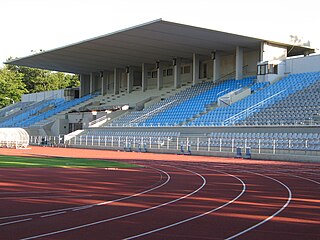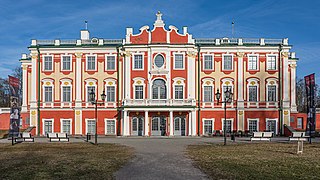
Tallinn is the capital and most populous city of Estonia. Situated on a bay in north Estonia, on the shore of the Gulf of Finland of the Baltic Sea, Tallinn has a population of about 461,000 and administratively lies in the Harju maakond (county). Tallinn is the main governmental, financial, industrial, and cultural centre of Estonia. It is located 187 km (116 mi) northwest of the country's second largest city, Tartu; however, only 80 km (50 mi) south of Helsinki, Finland, also 320 km (200 mi) west of Saint Petersburg, Russia, 300 km (190 mi) north of Riga, Latvia, and 380 km (240 mi) east of Stockholm, Sweden. From the 13th century until the first half of the 20th century, Tallinn was known in most of the world by variants of its other historical name Reval.

Konstantin Päts was an Estonian statesman and the country's president from 1938 to 1940. Päts was one of the most influential politicians of the independent democratic Republic of Estonia, and during the two decades prior to World War II he also served five times as the country's State Elder. After the 16–17 June 1940 Soviet invasion and occupation of Estonia, Päts remained formally in office for over a month, until he was forced to resign, imprisoned by the new Stalinist regime, and deported to the USSR, where he died in 1956.
An official residence is a residence designated by an authority and assigned to an official, and may be the same place where the office holder conducts their work functions or lives.

Johannes Vares was an Estonian and Soviet poet, medical doctor, and politician.

The Kumu Art Museum is an art museum in Tallinn, Estonia. It is one of the largest museums in Estonia and one of the largest art museums in Northern Europe. It is one of the five branches of the Art Museum of Estonia, housing its main offices.

Kadriorg Stadium is a multi-purpose stadium in Tallinn, Estonia. Opened in 1926, it is one of the oldest stadiums in Estonia. It is currently used mostly for track and field competitions, but also serves as a home ground for JK Tallinna Kalev. The stadium holds 5,000. Grandstand capacity is 3,524 seats and second stand has 1,476 seats. Kadriorg Stadium is located about 2 km east of the city centre in the subdistrict of Kadriorg near Kadriorg Palace. The address of the stadium is Roheline aas 24, 10150 Tallinn.

Alar Kotli was an Estonian architect. He studied sculpture at the art school Pallas in Tartu during 1922–1923 and mathematics at the University of Tartu. He graduated from the University of technology in Gdańsk in 1927 as an architect.

Banski Dvori is a historical building on the west side of St. Mark's Square in Zagreb, Croatia. It served as the official residence of the Croatian Bans (viceroys) and currently houses the Croatian Government.

Kesklinn is one of the 8 administrative districts of Tallinn, the capital of Estonia. It is situated on the Tallinn Bay and bordered to the northwest by the district of Põhja-Tallinn, to the west by Kristiine, to the southwest by Nõmme, to the east by Lasnamäe and Pirita, and to the south by Rae Parish, beyond Lake Ülemiste. The island of Aegna, located in the Tallinn Bay, also falls within this administrative district. Kesklinn has an area of 30.6 km2 (11.8 sq mi) and a population of 57,731 ; population density is 1,886.6/km2 (4,886/sq mi).

Ahja is a small borough in Põlva Parish, Põlva County in southeastern Estonia. Named after the Ahja River, it is located 191 kilometers (119 mi) southeast of Tallinn and about 16 kilometers (9.9 mi) north of Põlva.
This article covers the architecture of Estonia.

The Military Police Guard Battalion, or simply Guard Battalion is specialized unit under the Military Police of the Estonian Defence Forces, which conducts ceremonial duties and prepares military police units. It is based in Paldiski and specialized in urban warfare.

The Art Museum of Estonia was established in 1919. Originally based in Kadriorg Palace, the museum has expanded across several sites and today exhibits both international and local art works. At the end of the 1970s, in the 1980s the first branches of the Art Museum of Estonia were founded. Starting in 1995, all of the branches offer different educational programmes for children and young people. In 1996, the exhibition hall on the first floor of Rotermann Salt Storage was opened; this branch was closed in May 2005.

Kadriorg is a subdistrict in the district of Kesklinn ("Midtown"), Tallinn, the capital of Estonia. It has a population of 4,561. The subdistrict name derives from the Catherinethal, a Baroque palace of Catherine I of Russia. It is one of the wealthiest neighbourhoods in Estonia.

Kadriorg Palace is an 18th-century Petrine Baroque palace in Kadriorg, Tallinn, the capital of Estonia. Both the Estonian and the German names for the palace mean "Catherine's valley". It was built in 1718–1725 to Nicola Michetti's designs by Gaetano Chiaveri and Mikhail Zemtsov. The palace currently houses the Kadriorg Art Museum, a branch of the Art Museum of Estonia, displaying foreign art from the 16th to 20th centuries. The building of the Kumu branch of the museum, showing Estonian art from the 18th century onwards, is located nearby in the Kadriorg Park.

The Estonian Knighthood House is a building in Toompea, the upper part of Vanalinn, the historic inner town of Tallinn, the capital of Estonia. Its address is Kiriku plats 1. The Dome Church is situated at the same square.
The Embassy of the United States in Tallinn, Estonia, is located at the chancery building on Kentmanni Street. This building housed the U.S. legation to Estonia from April 1, 1930 until September 5, 1940. The U.S. Mission to Estonia resumed operations in the same building on February 6, 1992.

The San Carlos Palace, is a 16th-century Neoclassical mansion in Bogotá, Colombia. Located on the corner of Calle 10 and Carrera 5, the historic building has been the site of various political, social and academic events. Since December 1993, it has been home to the Ministry of Foreign Affairs.

Alatskivi Castle is a neo-Gothic castle in Alatskivi, Estonia. Dating to the 17th century, it is situated in Peipsiääre Parish, Tartu County. It was rebuilt in the late 19th century by Baron Arved von Nolcken, modeled on the royal residence of Balmoral in Scotland. A renovation occurred between 2005 and 2011. Five rooms on the first floor house the Eduard Tubin museum, which documents his accomplishments as a music composer and conductor.

Oskar Veldeman was an Estonian motorsport person, ski jumper and sport journalist.


















